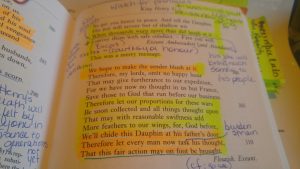I have always loved to take notes by hand. I believe that there is a connection between the hand moving the pen, the ink flowing on the page and the eyes transmitting those words to my brain that works for me personally. There is something beautiful in the hand written word. I also love books, but unlike some people who believe that books need to be pristine and always look as if they just came from the printers, I love to love my books. I dog ear them. I make comments in the margins of even fiction books, because I also love to reread books and I believe that great books should be read multiple times. This class has just increased and honed my, already active, annotation and note taking techniques.

I have seen in this class that Shakespeare’s plays offer us the most amazing variety of film adaptations with such amazing and diverse directors such a Branagh, Olivier, Kurosawa, Zeffirelli, Luhrmann, and Almereyda. I have used all of the resources that we have been learning when it came to working through the play-script One of the things that I found instrumental to truly understanding the text, was to watch as many different versions of the same scene as were available. Some we watched in class, but even more I watched at home as I went on a little Shakespeare movie binge.

Crowl does a very good job in Chapters 2 and 3 of his book Shakespeare and Film, of explaining the backgrounds of the directors and what to watch for in their directing style. I found that reading Crowl then following along with the text while watching a particular scene in a film, made me relate to the scene differently. I wasn’t just passively watching a movie, I was actually critiquing the auteurs deliberate choices. Choices that they made on what text to cut. What scenes to film. How to film a scene and what role the camera played. I also found that annotating Crowl’s chapters on the directors and having that information nearby while watching the films helped be to better understand how each director does have a style of their own from Olivier’s Henry V “the first Shakespeare film” (pg 23) which was a nod to his theater days to Branagh’s version in which from the very striking of the match, “we discover that we are not in a theater but a film studio” (pg 36).

For Henry V, I even watched the Branagh version and the Hollow Crown version with Tom Hiddleston as Henry and highlighted their directors choices of dialogue and I took notes on how each actor played the role. One of the many things that I have learned during the class is not just about note taking and annotating, although those are more important than I have realized previously, was that the music, lighting and tone of a scene can completely change what is conveyed to the audience. For example the Luhrmann version of Romeo and Juliet, the opening scene with the biting of the thumb, which is backed by the best neon colours, loud music, fast car and guns of Verona Beach, California in the 1990’s has a very different temperature, texture and taste from the 2013 Carlei scene which takes place in a traditional Italian Marketplace of Shakespeare’s time complete with full period costumes. My personal feelings about the movies aside, close reading, annotations and active viewing allowed to be delve deeper into the choices that each of the directors made in these films.
I believed that this course has not only taught me skills (annotation, note taking, close reading, etc) but it has actually changed the way I watch – well, everything. I may curse Dr. Ullyot later as I critique a Tim Hortons commercial or compare Law and Order to Criminal Minds, but I believe that I have come out of this course, a more informed consumer of books and films.
Leave a Reply
You must be logged in to post a comment.